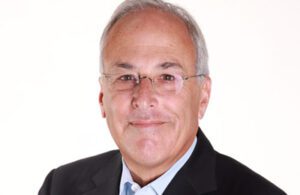
Moon Surgical Chief Strategy Officer Jeffery Alvarez. [Photo courtesy of Moon Surgical]
Some of the biggest names in the development of surgical robotics systems and virtual reality training technology discussed robotic surgery trends at DeviceTalks Boston.
Moon Surgical Chief Strategy Officer Jeffery Alvarez, Stryker Digital, Robotics, and Enabling Technologies President Robert Cohen, Osso VR CEO Justin Barad and FundamentalVR CEO and co-founder Richard Vincent see rapid changes ahead for surgical robotics and opportunities to win over surgeons, health systems and patients.
We’ve curated excerpts from the conversation, lightly edited for clarity and space.
Trends in surgical robotics
Alvarez: “There’s a transition from building robots that are hyper-specialized in one thing and do one thing really well, to platforms that are looking at how to solve bigger parts of the problem: How do we solve systematic issues in the operating room and develop platforms that work across a variety of procedures? That’s a big trend that we’re seeing now. When you look at architectures like CMR’s Versius or Medtronic’s Hugo, they’re moving toward trying to have some more of that adaptability to support more operations.”

Robert Cohen is president of Stryker’s Digital, Robotics and Enabling Technologies organization. [Photo courtesy of Stryker]
Cohen: “At Stryker — 45,000 people, almost $20 billion of sales — two years ago we spun off this new division that I’m proud to be part of called Digital, Robotics and Enabling Technologies. If you think about a company that’s somewhat conservative — Stryker’s been around for 80 years — doing something that disruptive to create a brand-new technology division within the company, that shows you it’s the times, right? It’s not necessarily just about implant designs anymore, it’s more about the technologies that help personalize medicine, help pre-op plan, better execute the plan. But for a company like Stryker to be able to do that and being so disruptive with things changing so fast, I’m proud that Stryker came to that conclusion. I’m proud to be part of this division, but I think it shows you where medtech is headed.
Stryker on steroids: How enabling technology will supercharge surgical robotics

Osso VR CEO Justin Barad [Photo courtesy of Osso VR]
Barad: “There’s an overwhelming number of procedures we need to learn and much longer learning curves. What’s becoming a big issue today is staff variability. So every surgery we’re doing, we’re often working with a different team. … You’re working with someone new every single day, and maybe they’ve never done orthopedic surgery before, general surgery before or any surgery before. Getting them up to speed quickly becomes a challenge. There are so many different varieties of robotic equipment out there. They’re getting upgraded on the fly and it’s almost like an entirely different surgery. So there’s a lot of challenges around training.”
Cohen: “The patients have changed over the decades. In 2010, if you were going for a total hip or total knee procedure, it was probably your children who were doing the investigation for you on the internet. Now that we’ve evolved and you have people getting at implants at an earlier age, people want to be more active and they go search online. Go look [online for] a Mako total knee and one of the first things you’re going see is better patient satisfaction. … We’ve been strong, loud and proud about accuracy and precision. … Once surgeons say, ‘I do a better job when I have a Mako robot and I am executing the plan I want,’ we’ve seen patient adoption, and they remember that those patients will actually repeat that. They feel better. They feel that they got a higher precision surgery because of a robot.”
More from DeviceTalks Boston: The ZimVie Tether helps kids with scoliosis — if they can get it in time
Accelerating the adoption of surgical robotics
Cohen: “If you address clinical issues, the market segment will grow. If you address two clinical issues, you will have a following. Mako started back in 2006 with a partial knee. It really did remarkable for a partial knee, but the indications are very narrow for a partial knee, and you didn’t get a lot of volume for that procedure, so you didn’t get a lot of podium time. It didn’t have enough interest. Hips evolved, but the hips were a little bit challenging to explain what the clinical issues were. In other words, a hip patient who may be walking with a limp is not necessarily in pain as much. The tipping point was in 2017 when Stryker released commercially the total knee application. Now you take a volume procedure where up to 30% of patients were dissatisfied…. Surgeons knew we did not have to create a market. Surgeons knew that the dissatisfaction rate wasn’t necessarily due to the implant design, per se. It was where that implant went: personalized medicine. And the robot was a way to get to that personalized medicine where you can do a pre-plan — in the case of Stryker off a CT scan — and take the virtual image of that individual and take virtual models of the implants that are going to go in that individual and make that joint line exactly where that patient needs it. Before, even if we did that, we didn’t have the tool to execute it in the operating room with accuracy and precision. The robot became the executor of the case. Then over a period of time, you see peer review literature from hundreds of surgeons about reduced readmission rates, reduce operation rates, better patient satisfaction, reduced pain, earlier return of flexion, less use of opioids. These are remarkable changes from a technology. And then the Australian registry and other government-run registries started to prove it. … One of the best indicators is we’re doing more than 30,000 Mako procedures on hips and knees a month. [Among health care providers that] have had total knee applications now for five plus years, the utilization rate is increasing and hospitals are buying more robots because now we don’t have to convince surgeons. Surgeons are convincing surgeons and they’re seeing their patients enjoy a Mako robotic experience. So more proof source, more literature, peer review, more talking about from the podium, but it was that total knee application that did it. It served a clinical need.”
Alvarez: “Soft tissue is very different. What we saw in the past two decades since da Vinci came on the market and really pioneered it is rapid adoption in prostatectomy. Now 90%, 95% of prostatectomy is done with the da Vinci system in the U.S. In the early 2010s, that’s really when it started to hit its chasm and needed to think about how to get beyond urology. They started building out a big array of instruments. Today, Intuitive has well over 33 different instruments, and that’s a big part of their ecosystem that makes them appealing to general surgeons. It’s that quiver of instruments that I think was a big tipping point for more adoption in general surgery, gynecology and elsewhere. The other key was as more surgeons became exposed to the technology, they really got an understanding of just how important ergonomics were to them. In laparoscopy, you can be holding very awkward, non-ergonomic positions for a long time, sometimes hours on end. That caused immense problems for surgeons. A da Vinci type of system helps get away from that in a way that prolongs surgical practice.”
Related: Dr. Fred Moll and Daniel Hawkins discuss the digital OR

FundamentalVR CEO and co-founder Richard Vincent [Photo courtesy of FundamentalVR]
Vincent: “When you can hand it over [to the surgeons], you pass the pen to the user and say, ‘OK, you tell us what you can do with this, how can you start to create and you start to really find benefit here?” That’s when it starts to have a momentum of its own.”
Barad: “Robotics as a whole is so exciting and holds so much promise, but some of the research is not as exciting as we’d like in terms of what is the true value of robotics. [In] the orthopedic space you’re starting to see real value in much more consistent outcomes. For total knee replacement, patients with Mako are 10% less likely to have postoperative pain, which is a huge issue for arthroplasty surgeons. It’s very exciting to me as a surgeon. My goal is how do we get more people to use these technologies and how do we get them to use them correctly. My concern is that when we do these studies or if we’re doing a clinical trial for a new technology, if you’re not fully trained on it you’re not actually going to realize the full value of the technology. And then you may misinterpret in a clinical study or a clinical trial that it didn’t work, it wasn’t better than the way we used to do things, when in fact the people that were doing it weren’t fully trained on it. And we saw that with Ardian, which was acquired by Medtronic and is still shelled for renal denervation. When they did a postmortem on the clinical trial, the issue is that there was a lack of training of the providers that were enrolling patients and operating on them. So this is a huge issue that affects every part of care delivery and I think is one of the bottlenecks to the explosion in technology that is waiting for us to improve value for all patients.”
Vincent: “If you go away from early-stage learning in a residency fellowship and think about tenured surgeons acquiring a new skill — using a robot — that can in some cases have a demonstrable positive impact on patient outcomes, but it’s interfering with the OR flow often. And there’s a relearning that needs to happen there. There’s a technical setup piece that needs to happen. And of course, that’s across an enormous group of individuals, not just the physicians themselves or the surgeon. You’ve got the supporting staff, the team, the tech, etc. who all need to understand that on a rolling basis. Finding ways to digitize that to increase the velocity of skills acquisition in that space for me has really been exciting.”
How surgical robotics can help address hospital staffing shortages
Alvarez: “Laparoscopy is really a spectrum. On one side, you have traditional laparoscopy where the surgeon and the OR staff have dispersed instruments between them and they’re working in concert to try to achieve a goal. On the other end of the spectrum you have telerobotic systems like da Vinci, large, complex systems. They have 60-plus procedure learning curves and they’re quite expensive. There’s nothing in between. That’s where Moon Surgical comes in. … We’ve really created this new category of robotic surgery that enhances existing laparoscopic tools and techniques and really changes the equation for surgeons and hospitals and patients, and really helps improve the bottom line of facilities as well. In the operating room, we allow the surgeon to have complete control over all the instruments and not have to rely on some other team members. And so the byproduct of the system design is the need to have one less person, and that’s incredibly important in today’s world. We lost over one million healthcare jobs in the first year of the pandemic.”
More: How device manufacturers are mitigating high-risk exposure to hospital budgets
Cohen: “We ask all the time, ‘How can Stryker contribute to OR efficiency?’ Having a plan set prior to the surgery actually helps reduce the mental anguish [for a surgon of] what implant am I going to use, what size? You’re walking in pretty comfortably. We’re actually seeing ORs have more procedures per day, and efficiencies are actually able to get more income out of the same operating room. Now the next question becomes, can we reduce a nurse in the OR with some automation and address the high cost of nursing and address the nursing shortage? We’re looking at that related to workflow, but improved outcomes come first.”
MassDevice: 16 surgical robotics companies you need to know